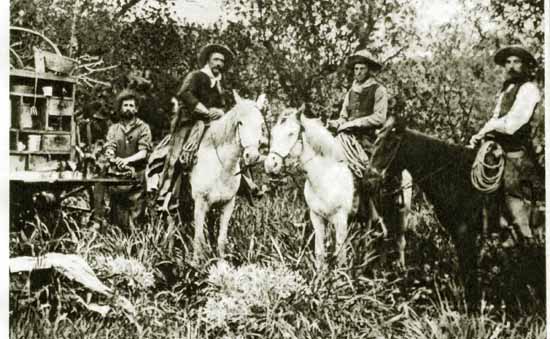
Nate Champion on left-most horse, Dudley Champion at far right, 1880's.
On the morning of April 5, 1892, a three car special Union Pacific Train pulled out of
Denver bound for Cheyenne. On board were Tom Smith, 22 hired Texas gunmen including former Johnson County Sheriff
Frank Canton, the 225 lb. Jim Dudley, clad only in trousers, shoes and a light shirt, and the expedition
physician, Charles Penrose.
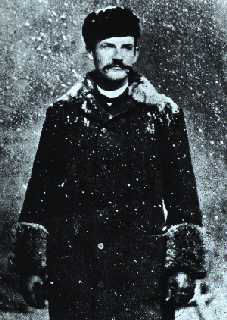 Frank Canton
Frank Canton
|
Canton had served as sheriff for four years, 1882-1886, and was unrelenting in his opposition to rustlers. He was responsible for a territory that included not only
present day Johnson and Sheridan Counties, but parts of present day Washakie, Big Horn and
Hot Springs Counties. During his term he captured the notorious Teton Jackson (see The Grand Tetons),
and hanged the murderer Bill Booth who poisoned his victims (the only legal hanging ever
conducted in Johnson County). It cost the county $44.03 for the lumber for the scaffold. It often required two stage coaches at a time to carry his prisoners off to
the territorial prison. After Canton left office, there was certainly no friendship
lost between Champion and Canton. Canton took employment as a stock detective with the
Wyoming Stock Growers Association. On November 1, 1891, four gunmen
attacked Ross Gilbertson and Nate Champion who were in a line shack on Powder River. Champion accused Canton of being one of
the gunmen. It is now believed that the four were Joe Elliott, Tom Smith, Frank Canton, and Fred Coates. Elliott was
also in the employ of the WSGA as a cattle detective and had previously worked for the 101 near present day Moorcroft.
Harry Sinclair Drago in his The Great Range Wars: Violence on the Grasslands,
University of Nebraska Press, 1985, summed up Canton,
"Frank Canton was a merciless, congenital, emotionless killer.
For pay, he murdered eight -- very likely ten men." Drago concluded,
"Even Jesse James was kind to his mother."
At Cheyenne, a baggage car, three stockcars, a caboose, and a flatcar bearing three Studebaker freight wagons laden with dynamite
and other supplies, were added to the
special. At Cheyenne, various stockmen including W. C. Irvine, Bob Tisdale, and John Tisdale (unrelated to the
Tisdale that had been murdered) boarded the train, along
with two newspaper reporters, Ed Towse of the Cheyenne Sun and Sam T. Clover of the Chicago Herald.
Off into the night, with the stockmen and the
Texans separated, the train proceeding north, under the command of
Wolcott. The special stopped once to confirm that the
telegraph line to the sleeping town of Buffalo was down.
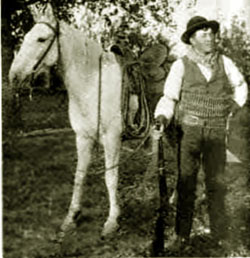 Mike Shonsey
Mike Shonsey
|
Matters almost from the beginning went awry. Major Wolcott got into an argument with
Smith and Canton, which resulted in Wolcott resigning his command. Smith became the
leader of the Texans, and Canton commander of the expedition. The expedition detrained
at Casper. There, difficulties were encountered in finding a horse big enough for
Dudley. But soon the party was underway, but going was slow. First there was the mud.
Then, at breakfast the horses broke loose. One of the heavily laden Studebakers broke
through a bridge. Then the party ran into an unexpected snowstorm. It took two days
to reach the anticipated first night's destination, Tisdale's ranch. There, Canton, concerned
about the delay, urged attacking Buffalo directly. Mike Shonsey appeared. He reported that he
had spent the previous night at the KC and Champion was there with Ray and two trappers.
[Writer's note, some sources indicate that Shonsey lied and told the expedition that there
were 14 rustlers holed up in the cabin.]
With the prospect of a bird in hand, the party voted to
attack Champion's KC, fifteen miles away. The snow worsened and it took six
hours to make it to the KC.
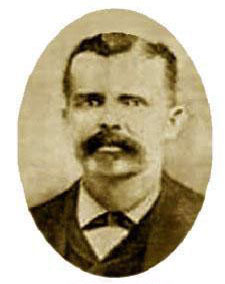 Tom Smith
Tom Smith
|
Meanwhile, at the KC, a modest establishment consisting of little more than a cabin and a stable, there were
four occupants, Nate Champion; Nick Ray, an unemployed itinerant Missouri
cowboy, perhaps "working the line;" and two trappers, Ben Jones and Bill Walker, spending the night because of the
raging blizzard. Wyoming, because of distances, desolation, and loneliness, has had a tradition of hospitality. Thus, travelers were
always welcome for a meal. In the winter before spring roundup when there was little work,
waddies or itinerant cowboys would "work the grub line" by stopping at cabins and
ranches where they knew they could receive a warm meal and be welcome.
During the predawn hours, the expedition occupied the stable, a creek bed and
ravine near the cabin and lay in wait.
In the morning, Jones came out to get a pail of water and was promptly captured by the
self-styled "regulators." Walker came out looking for his partner and was also
taken. Champion busied himself fixing breakfast and Ray emerged to get firewood. A shot, allegedly fired by
a young regulator, D. E. "the Texas Kid" Brooke. hit
Ray. The Kid was so called because he was barely old enough to
shave. Champion grabbed Ray, pulling him back into the cabin. During the day,
Champion and the "regulators" exchanged shots. During lulls, Champion kept a log in an old notebook, later
printed by Sam Clover:
"Me and Nick was getting breakfast when the attack took place.
Two men was with us- Bill Jones and another man. The old man went after
water and did not come back. His friend went to see what was the matter
and he did not come back. Nick started out and I told him to look out,
that I thought there was someone at the stable and would not let them
come back.
Nick is shot but not dead yet. He is awful sick. I must go and wait on him.
It is now about two hours since the first shot. Nick is still alive.
Boys, there is bullets coming like hail. They are
shooting from the stable and river and back of the house.
Them fellows is in such shape I canít get at them. They are shooting from
the stable and river and back of the house.
Nick is dead, he died about 9 o'clock. I see a smoke down at the
stable. I think they have fired it. I don't think they intend to let me get away this
time.
Boys, I feel pretty lonesome just now, I wish there was someone here with me so we
could watch all sides at once.
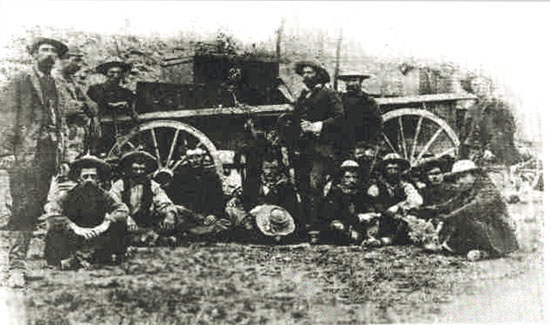
Bar C Round-up Wagon
Left to Right, Standing: H. W. "Hank" Devoe, Ray Peters; George Gordon; Cheston Morris; Nate Champion; Joe Vincent.
Seated: Buck Jackson, Jack Donahue, (Edward H.?) Hall, Hice McCarty, Segal "Sig" Donahue, Martin Allison "Johnny" Tisdale,
Bill Rankin, Jack Flagg.
Hank Devoe was the foreman of the Bar C. The Bar C was a small British-owned outfit.
About three o'clock, Champion notes in the log that two men had passed by and were fired on,
"I seen lots of men come out on horses on the other side of river and take after them."
Unbeknownst to Champion, the men passing by were Oscar Hite "Jack" Flagg and his stepson. Flagg was a neighbor and
one with whom Champion had ridden roundup on the old Bar C Ranch before it went broke. Flagg was one of the cowboys
that had been blacklisted by the WSGA as was Johnny Tisdale. Flagg took up a homestead on the Red Fork of
Powder River a short distance below the mouth of Devoe Canyon. [Writer's note, Flagg was also a
distant cousin of the writer's mother-in-law.]
Jack Donahue previously had been foreman for Sir Horace Plunkett but was fired and replaced by
Phil DuFran.
After Johnny Tisdale was
bushwhacked, Donahue, with two others,
discovered the body. Johnny's body was lying over Christmas toys he was taking
home for his children.
Flagg and his stepson made good
their escape and raced to Trabing's Postoffice about 16 miles southeast of Buffalo to raise the alarm. There, they raised a
small posse to come to the relief of Champion. On the way back to the K C they met another posse who had learned of the
invasion from Terrence Smith, a neighbor of the K C. Smith had heard the shooting coming from the
K C and realized its import. The two groups of men combined their forces. Smith raced the 60 miles to
Buffalo to alert Sheriff Angus. With another posse of 12 men, the Sheriff rode to the K C where they found the body of
Champion and with the burned cabin the charred remains of Ray. With the
word out, the Sheriff was able to raise a posse of over two hundred men, all of whom were deputized
by Sheriff Angus. Indeed, it appears that some in the posse may have actually taken up arms
against their employers. Thus, John J. Baker, joined Sheriff Angus's posse. Baker,
a Texan, had been orphaned at age 9. By age 13 he was a cowboy. Later he trailed cattle up from
Texas and joined the Niedringhaus Brothers' N Bar N. By 1892, he was riding for
the W L Ranch in Johnson County, but was fired when he refused to join the regulators. Instead,
he joined with Sheriff Angus.
The Posse can be traced back to pre-Norman Conquest England. There the sheriff could raise a
"hue and cry" in which the sheriff could require able-bodied men to join in chasing violators of the law. The office
of sheriff can be traced back to at least the 9th Century. Indeed, the office is the second oldest
in the English-speaking world; only the office of the Crown is older.
But enough of the digression. Meanwhile back at the ranch, the battle continued with Champion writing:
"I heard them splitting wood. I guess they are going to fire the house
to-night.
I think I will make a break when night comes if alive.
The regulators took a wagon and loaded it with flamables and shoved it into the cabin.
Champion's final message written in the notebook:
The house is all fired. Goodbye boys, if I never see you again.
Nathan D. Champion
Champion dashed out the rear door of the cabin and was hit in the leg by a shot. Then
a shot from Shonsey hit Champion, but the regulators kept firing, ultimately there were more than 24 bullets
in Champion. And there his body lay for several days, and, according to the New York Times, April 14, 1892,
coyotes ate "nearly all of it." Of Ray's corpse there was "left but the skull and part of the shoulders."
Next page, Johnson County War continued, the seige at the TA.
|